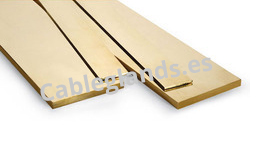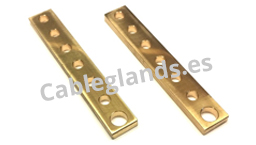

Technical Data For Brass Bus Bars
- Design Standards: IACS, ASTM B187, EN 13605, BS 159, NAS 44, CSA C22-2
- Materials: Brass, Free Cutting Brass, Tin Plated Brass, Copper, Free Machining Copper, Silver Bearing Copper, High Conductive Copper
- Electrical Conductivity: 98.0 % IACS minimum
- Chemical Composition: 99.90 % of Copper
- Execution: Three Pole or Four Pole
- Rating: 32 Amps. to 1000 Amps. 415 V, 50 Hz
- Maximum Operating Temperature: 260°C
- Finish: Cadmium types I & II, Chrome, Degreasing, Bright Nickel, Pickling, Silver, Bright Tin, Hot Tin Dip and Zinc types I & II, Black Oxide
Features of Brass Bus Bars
- Uninsulated and have sufficient stiffness to be supported in air by insulated pillars.
- Produced in variety of shapes, such as flat strips, solid bars or rods.
- Typically composed of copper, brass or aluminium as solid hollow tubes.
- Earthing Busbars are typically bare and bolted directly onto any metal chassis of their enclosure.
- Distribute electricity with greater ease and flexibility than some other more permanent forms of installation and distribution.
- Brass Bus Bars provide faster installation, flexibility and environmentally friendly features.
- Improve efficiency and Exposing more of the copper surface area and increasing a balanced electrical flow while decreasing its ampacity.
- High Conductive, Resistant to damage, Higher performance in clamped joints, Lower co-efficient of linear expansion and Higher modulus of elasticity.
- Decrease joint resistance which increases jointing efficiency in electrical systems.
- Ideal extrusion and drawing die design gives flexibility of operations for sliding and intricate electrical refining plants.
Benefits of Brass Bus Bars
- Typically housed inside switchgear, panel boards, and busway enclosures for local high current power distribution.
- Used to connect high voltage equipment at electrical switchyards, and low voltage equipment in battery banks.
- Busbars may be enclosed in a metal housing, in the form of bus duct or busway, segregated-phase bus, or isolated-phase bus.
- Busbars may be connected to each other and to electrical apparatus by bolted, clamped or welded connection.
- Provide an easy and convenient way to connect individual electrical wires.
- Fabricated Bus Bars provide a quick, convenient and economical solution for panel switchboard and switchgear makers.
- Enables simple expansion, reconfiguration or relocation operations and the shape applies continuous pressure to every joint creating a solid connection and eliminating the need for routine maintenance.
We can manufacture and export Brass Bus Bars as per specifications (custom drawing and samples) for more information please Contact us